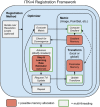The Insight ToolKit image registration framework
- PMID: 24817849
- PMCID: PMC4009425
- DOI: 10.3389/fninf.2014.00044
The Insight ToolKit image registration framework
Abstract
Publicly available scientific resources help establish evaluation standards, provide a platform for teaching and improve reproducibility. Version 4 of the Insight ToolKit (ITK(4)) seeks to establish new standards in publicly available image registration methodology. ITK(4) makes several advances in comparison to previous versions of ITK. ITK(4) supports both multivariate images and objective functions; it also unifies high-dimensional (deformation field) and low-dimensional (affine) transformations with metrics that are reusable across transform types and with composite transforms that allow arbitrary series of geometric mappings to be chained together seamlessly. Metrics and optimizers take advantage of multi-core resources, when available. Furthermore, ITK(4) reduces the parameter optimization burden via principled heuristics that automatically set scaling across disparate parameter types (rotations vs. translations). A related approach also constrains steps sizes for gradient-based optimizers. The result is that tuning for different metrics and/or image pairs is rarely necessary allowing the researcher to more easily focus on design/comparison of registration strategies. In total, the ITK(4) contribution is intended as a structure to support reproducible research practices, will provide a more extensive foundation against which to evaluate new work in image registration and also enable application level programmers a broad suite of tools on which to build. Finally, we contextualize this work with a reference registration evaluation study with application to pediatric brain labeling.
Keywords: MRI; brain; death; open-source; registration.
Figures







Similar articles
-
ITK: enabling reproducible research and open science.Front Neuroinform. 2014 Feb 20;8:13. doi: 10.3389/fninf.2014.00013. eCollection 2014. Front Neuroinform. 2014. PMID: 24600387 Free PMC article.
-
Integrating segmentation methods from the Insight Toolkit into a visualization application.Med Image Anal. 2005 Dec;9(6):579-93. doi: 10.1016/j.media.2005.04.009. Epub 2005 Sep 26. Med Image Anal. 2005. PMID: 16185910
-
A flexible registration and evaluation engine (f.r.e.e.).Comput Methods Programs Biomed. 2007 Aug;87(2):81-92. doi: 10.1016/j.cmpb.2007.04.009. Epub 2007 Jun 14. Comput Methods Programs Biomed. 2007. PMID: 17574703
-
Ultrasound registration: A review.Methods. 2017 Feb 15;115:128-143. doi: 10.1016/j.ymeth.2016.12.006. Epub 2016 Dec 11. Methods. 2017. PMID: 27965119 Review.
-
Survey of Non-Rigid Registration Tools in Medicine.J Digit Imaging. 2017 Feb;30(1):102-116. doi: 10.1007/s10278-016-9915-8. J Digit Imaging. 2017. PMID: 27730414 Free PMC article. Review.
Cited by
-
Sildenafil administration improves right ventricular function on 4D flow MRI in young adults born premature.Am J Physiol Heart Circ Physiol. 2021 Jun 1;320(6):H2295-H2304. doi: 10.1152/ajpheart.00824.2020. Epub 2021 Apr 16. Am J Physiol Heart Circ Physiol. 2021. PMID: 33861148 Free PMC article.
-
Feasibility of high-resolution perfusion imaging using arterial spin labeling MRI at 3 Tesla.Front Physiol. 2024 Jan 3;14:1271254. doi: 10.3389/fphys.2023.1271254. eCollection 2023. Front Physiol. 2024. PMID: 38235379 Free PMC article.
-
Anatomical correlates of category-selective visual regions have distinctive signatures of connectivity in neonates.Dev Cogn Neurosci. 2022 Dec;58:101179. doi: 10.1016/j.dcn.2022.101179. Epub 2022 Nov 24. Dev Cogn Neurosci. 2022. PMID: 36521345 Free PMC article.
-
Alterations of Microstructure and Sodium Homeostasis in Fast Amyotrophic Lateral Sclerosis Progressors: A Brain DTI and Sodium MRI Study.AJNR Am J Neuroradiol. 2022 Jul;43(7):984-990. doi: 10.3174/ajnr.A7559. Epub 2022 Jun 30. AJNR Am J Neuroradiol. 2022. PMID: 35772800 Free PMC article.
-
Microstructural Tissue Changes in a Rat Model of Mild Traumatic Brain Injury.Front Neurosci. 2021 Nov 26;15:746214. doi: 10.3389/fnins.2021.746214. eCollection 2021. Front Neurosci. 2021. PMID: 34899158 Free PMC article.
References
LinkOut - more resources
Full Text Sources
Other Literature Sources

